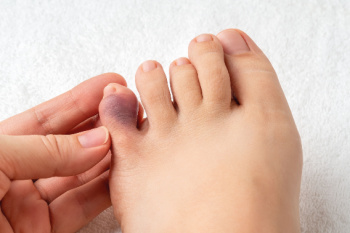Connect With Us
Blog
Items filtered by date: May 2025
Symptoms and Causes of a Broken Pinky Toe

A broken pinky toe can cause significant discomfort despite the small size of the bone. Symptoms include immediate pain, swelling, bruising, and difficulty walking or putting weight on the foot. In some cases, the pinky toe may appear crooked or out of alignment, and touching or moving the toe can increase the pain. Causes of a broken pinky toe typically involve direct trauma, such as stubbing the toe against a hard object, dropping something heavy on the foot, or twisting the foot awkwardly during a fall or misstep. Stress fractures from repetitive impact activities can also affect the pinky toe. If you believe you have broken your toe, it is suggested that you contact a podiatrist who can accurately diagnose this condition and offer appropriate treatment.
A broken toe can be very painful and lead to complications if not properly fixed. If you have any concerns about your feet, contact James Torhorst, DPM from Torhorst Foot and Ankle. Our doctor will treat your foot and ankle needs.
What to Know About a Broken Toe
Although most people try to avoid foot trauma such as banging, stubbing, or dropping heavy objects on their feet, the unfortunate fact is that it is a common occurrence. Given the fact that toes are positioned in front of the feet, they typically sustain the brunt of such trauma. When trauma occurs to a toe, the result can be a painful break (fracture).
Symptoms of a Broken Toe
- Throbbing pain
- Swelling
- Bruising on the skin and toenail
- The inability to move the toe
- Toe appears crooked or disfigured
- Tingling or numbness in the toe
Generally, it is best to stay off of the injured toe with the affected foot elevated.
Severe toe fractures may be treated with a splint, cast, and in some cases, minor surgery. Due to its position and the pressure it endures with daily activity, future complications can occur if the big toe is not properly treated.
If you have any questions please feel free to contact our offices located in Waupaca and Stevens Point, WI . We offer the newest diagnostic and treatment technologies for all your foot and ankle needs.
